Did you see the Scandinavia DNA ethnicity in your ethnicity estimate? Do you want to know more about this DNA ethnicity region? You have come to the right place to learn how you inherited this fascinating region.
DNA testing can lead us to learn a bit about genetics, geography, and history in the context of our roots. Hopefully we have some fun in the process, too!
In this article, you will learn:
- Where to find Scandinavia on the map
- How Scandinavia spread to other parts of Europe
- How Scandinavia ended up in your DNA
- Whether you can trace your Scandinavian ancestry
- How to research your Scandinavian ancestry
Whether you you have distant Scandinavian ancestors, or more recent ones, and whether you have small amounts (or large percentages!) of Scandinavian DNA, you will be able to learn more about your Scandinavian past from this article.
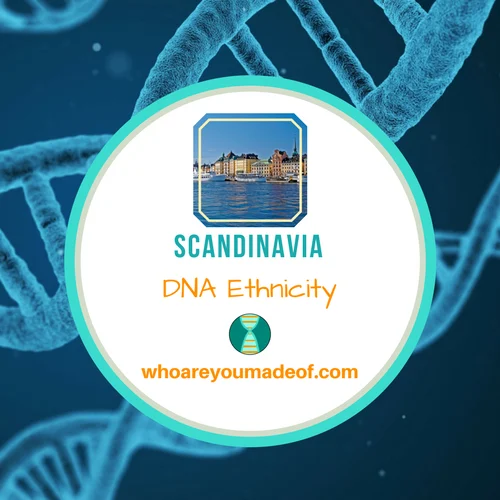
Tip: Don't miss my DNA Tools Page where I've compiled a list of my most helpful blog posts and other excellent resources to help you understand your DNA results.
Where is the Scandinavia DNA region located?
If you look at the map below, you will see that Scandinavia is located in the northernmost part of the European continent on the Scandinavian Peninsula:
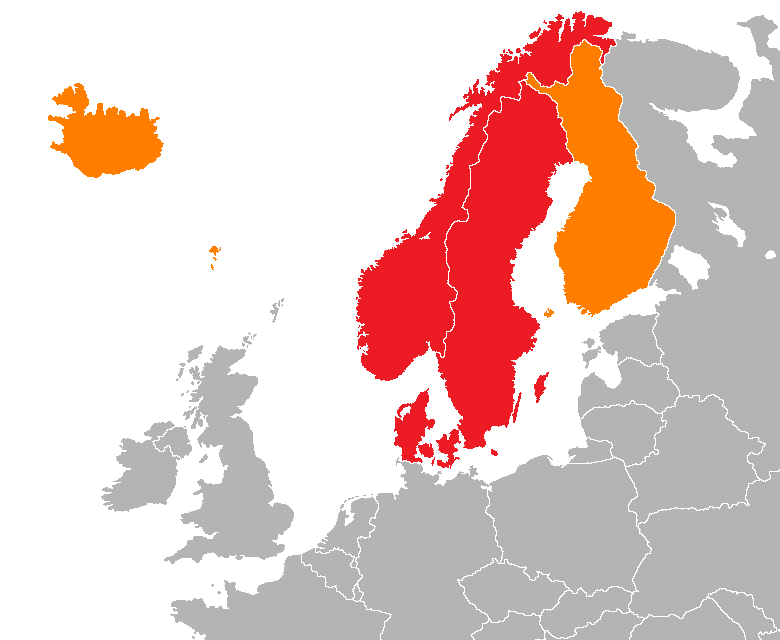
Cool fact: The Scandinavian Peninsula is the largest peninsula in Europe!
Which countries are included in the Scandinavian DNA region?
The countries that are always accepted as being part of the Scandinavian region are: Denmark, Norway, and Sweden, since they are located on the peninsula. These countries, along with Iceland and other places where North Germanic languages are spoken, are also often referred to as part of Scandinavia because of the language similarities.
This is information is very relevant, especially when considering Scandinavia as a DNA ethnicity. Finland, the country that you see in orange, to the right of the Scandinavian Peninsula (the easternmost country) is not typically considered part of Scandinavia.
People have been living on the Scandinavian Peninsula for at least 12,000 years. Initially, only the southern part of Scandinavia was occupied, but as the ice sheets retreated, people were able to populate areas further north.
There are two broad "categories" of original peoples whose descendants have populated the region: the indigenous Sami people (also called Laplanders), and ancient Germanic tribes.
So What is Scandinavian DNA?
When some people see the Scandinavian DNA ethnicity in their test results, they are concerned. Maybe they don't have any known Norwegian, Swedish or Danish ancestors, or they didn't have any known European ancestry to begin with.
Even though Scandinavian DNA is most commonly found in Sweden, Norway, and Denmark, it is also found in the following areas:
- Great Britain
- France
- Germany
- Netherlands
- Belgium,
- The Baltic States (Estonia, Latvia, and Lithuania)
- Finland
People who are native to regions close to the Scandinavian Peninsula are likely to show relatively higher amounts of Scandinavian DNA. For example, between 24-27% of people who are native to Finland, parts of Western Europe, or Great Britain, show Scandinavian DNA.
If you compare this to a region further away, such as Southern Europe (Italy and Greece), only about 2% of people show this particular DNA ethnicity.
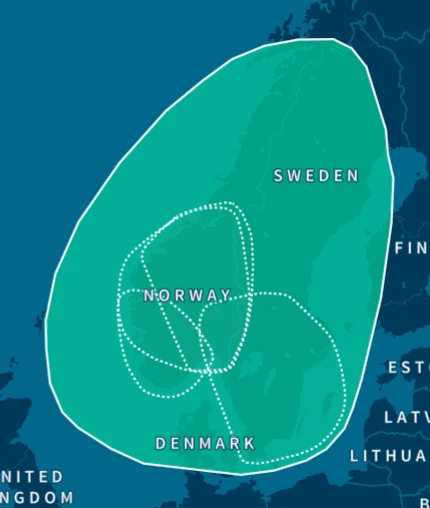
Why Is there Scandinavian DNA in Other Parts of Europe?
There a few major trends that influenced genetic diversity in this part of Europe. Have you heard of the Vikings?
Between the Vikings' raids and settlements, expanding political borders, immigration and trade, it is fairly easy to imagine how Scandinavian DNA made its way around the continent.
Viking raids, settlements, and the spread of Scandinavian DNA
The Vikings were an incredibly adept seafaring people. In fact, there is extensive evidence of Norse (Viking) contact with Native American populations in Canada hundreds of years before Christopher Columbus' voyage to America in 1492.
I don't like to generalize about an entire group of people, but there is significant evidence that the Vikings were fairly violent. For about three hundred years, the Vikings, utilizing their knowledge and abilities about war and traveling by ocean, terrorized a large portion of Europe.
Eventually, they began to create permanent Viking settlements and form political entities.
Two Vikings actually became kings in England, in the 11th century, and the French Normans were also descended from the Vikings. Their influence on Europe was incredible: take a look a the map below to see the areas where the Vikings formed settlements and conducted raids.
You can see from the map below that they reached as far south as North African, as far west as Greenland, and as far east as Iran.
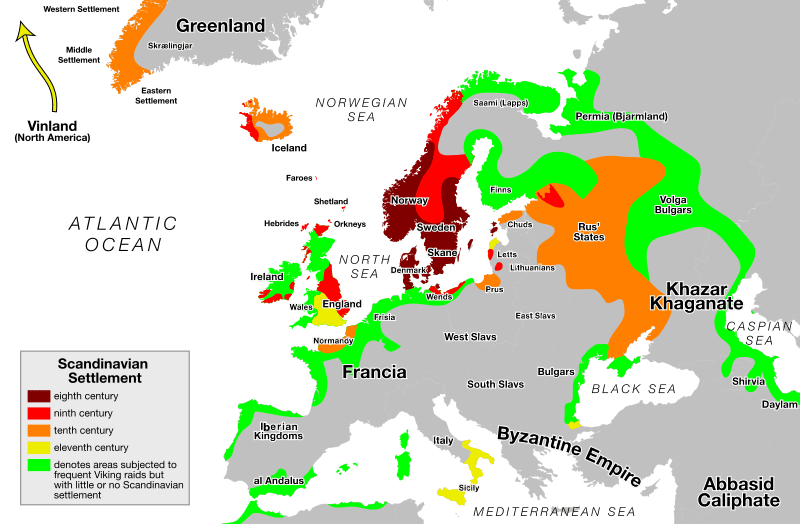
Image Credit: Max Naylor, who I thank for this public domain image!
During these raids, and later, during Viking settlements, Scandinavian DNA was spread through intermarriage, and probably even through violent means.
It might seem strange that DNA from this time period could still show up in an autosomal DNA test in the 21st century. However, if you consider that in certain communities, there was a very high amount of Scandinavian DNA to begin with, it doesn't seem so strange that there are still many people with DNA from this region that originated with the Vikings.
It's interesting to note that the Norse/Viking relationship with the rest of Europe began to change as Christianity took more of a foothold in the region.
There are several cited reasons, one of the major ones being that the church frowned upon owning Christians as slaves, and since most of the surrounding areas were also becoming Christian, it became economically unprofitable to raid, since slaves had been a substantial profit making activity for the Vikings.
Swedish expansion into the Baltic States - DNA explanation
Scandinavian countries have had established political organizations for more than 1,000 years, but the actual geographic boundaries have shifted substantially, repeatedly, during this time.
For example, in the late 1500's, Sweden expanded its borders to include parts of northern Germany, the Baltic countries, and even territories that previously belonged to Russia.
The Swedish Empire continued to expand until the 1700. This provided ample opportunity for Scandinavian DNA to expand along with the empire.
Scandinavian immigration to the Netherlands - Recent Scandinavian DNA
One of the most recent trends that involved Scandinavian DNA moving about Europe was the immigration of as many as 80,000 Norwegians to the Netherlands in the 1600 and 1700s.
Many of the young male immigrants ended up working as sailors in the Navy, or on merchant ships. The young women often found employment as domestic servants.
These immigrants were attracted by the religious freedoms enjoyed by the Dutch people, and naturally, their strong, growing economy.
Of course, most of these immigrants ended up staying in the Netherlands, and their descendants likely moved throughout Europe in later generations.
How did I get Scandinavian DNA?
I am assuming that most people reading this article live in the United States, and are curious to know how Scandinavian DNA might have ended up in their DNA results.
While the only true way to really know where your Scandinavian came from is to build a family tree using DNA as your guide, I do have some ideas for you that might help point you in the right direction.
I always build my family trees on Ancestry, which is where you could start building your tree (if you already haven't). It's free to build a tree, but it's easier if you have subscription, which I recommend.
If you need help getting started with how to do family tree research, I recommend checking out my softcover book on Amazon, Family Tree Building Basics: A Book for Beginners, which is also available via immediate PDF download.
Large amounts of Scandinavian in DNA results (more than 20%)
Large amounts of Scandinavian DNA could indicate a recent Scandinavian ancestor, especially if you tested with Ancestry DNA and were assigned a sub-region of Scandinavia.
If you have small amounts of Scandinavian from several (or several dozen) distant ancestors, it is unlikely that your DNA would match the profile of a specific sub-region of Scandinavia.
It is theoretically possible to have inherited small amounts from many different ancestors. We inherit 50% of our DNA from each parent, and our parents inherited the same from their parents.
The DNA that we inherit from our ancestors shows the parts of the world that they likely lived in, as well as their ethnicity. It's possible that the several generations back all coincidentally inherited more Scandinavian ethnicity and less of the other available ones (obviously with the limitation of each person only getting 50% of each parents' DNA)
Small amounts of Scandinavian in DNA results (less than 20%)
- Can indicate one Scandinavian ancestor 3-5 generations back, though it is also common for a person to have several very distant ancestors of one ethnicity and inherit small amounts from more than one of them.
Can I Trace My Scandinavia Ancestry?
Depending on how far back your Scandinavian ancestors are, you might be able to find them. If the person (or people) contributing some of your Scandinavian ancestry to your genome were Viking, for example, it's extremely unlikely that you would be able to trace your history back that far.
If you believe that your Scandinavian ancestry is more recent, like from the 1600 or 1700s, for example, there is a good chance that you might be able to find documentation of how it came into your family line.
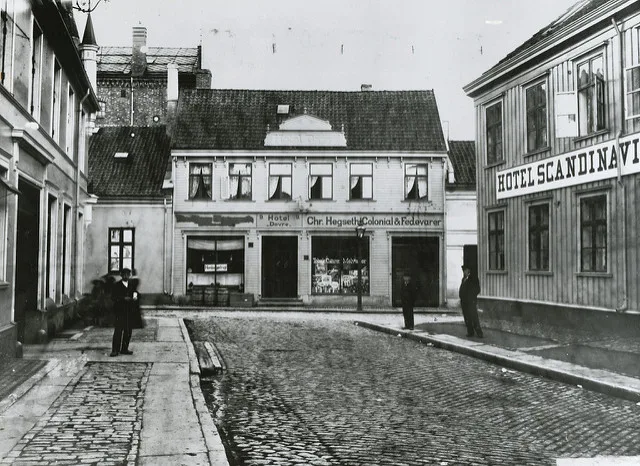
How to Research My Scandinavia Ancestry?
The first thing that anyone should do if they are interested in finding out how they got their Scandinavian genes is to start building a family tree. I recommend using Ancestry for this, since you can start your tree and easily access relevant records to build back more generations.
Conclusion
I hope that this post helped you understand a little bit more about Scandinavian DNA, how it ended up in your DNA results, and what it really means as far as tracing your family history.
If you have questions about anything that I have mentioned here, or would just like to leave your story for others to read, I would love to hear from you in the comments.


Debbie
Sunday 28th of July 2024
My dad came back 77% Scandinavian. Both his parents were born in the UK and as far as we are aware all ancestors are British. I can only assume the result is incorrect and will need to take another test. Otherwise I’m assuming one of his parents is the off spring of a Scandinavian without knowing it. But if you only inherit 50% from a parent how is he 77% Scandinavian?
Vanessa Stafford
Saturday 23rd of December 2023
I have 53.2% Scandanadian DNA no idea where I come from and as I’m almost 70 my relatives are dead and I don’t know how to find out. I have very limited info on them. And am curious as I have such a high percent of Scandinavian DNA how far does it go back and why is it so strong, sure if it goes back to the Vikings it wouldn’t be so strong. Any ideas. And I don’t have money to spend on finding out.
Jason
Monday 12th of September 2022
Hi Mercedes -- thanks for running this webpage. I can't say my DNA results ever shocked or surprised me; both my parents' ancestors came to North America in the 17th century (aside from my mom's Jewish grandparents) and were, according to the family and to records, basically English with one French couple on my dad's side. Still, I was intrigued by the amount of Swedish/Danish ancestry I have (Scottish, too, though that wouldn't be for this post). So I have some questions:
1) I'm usually skeptical of genealogies linking back to nobility and royalty, but last week my daughters, currently obsessed with the musical "Six," made me look up our connection to Anne Boleyn on FamilySearch, and it turns out that she's a distant cousin. So is Katherine Howard. Jane Seymour is my 14th great-grandaunt, supposedly. Thomas Cromwell is my 15th great-grandfather. William the Conquerer is... somewhere down there. I laughed it off, because FamilySearch can be very unreliable, but some of these connections were well and reliably sourced. If most lines came from outside the Danelaw, does Nordic = Norman?
2) Why don't Anglo-Saxons show up as Scandinavian, when they were originally from just south of Denmark?
England & Northwestern Europe45%
Jewish Peoples of Europe
Sweden & Denmark14%
Scotland14%
Norway2%
Germanic Europe1%
Ireland 1%
GRC
Tuesday 6th of September 2022
Are you still accepting comments on this article?
GRC
Monday 5th of September 2022
I have recently found that I have 53% Swedish DNA on Ancestry. Reconfirmed with MyHeritage; nearly the same percentage. Also, DNA Matches page on Ancestry shows that I have at least three 1st to 2nd cousins hailing from the immediate areas of where I was brought up. No Swedish names appear anywhere in my family tree on either side, all the way back to the 1300s. With these 1st or 2nd cousins having been from the same areas of my youth, and with first cousins being the children of a parents' sibling, I am left to wonder. Even though the percentages themselves cannot be used to explore or verify paternity issues, certainly the presence of a 1st cousin (or two) of new-found Swedish descent signals that something is hidden from me.